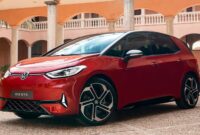In 2021, Volkswagen issued a press release regarding its intention to become a “provider of software-driven mobility”. Marketing jargon aside, the announcement also includes news about the upcoming ninth-generation Golf later this decade. Fast forward to August 2022, CEO Thomas Schäfer speaks with Die Welt on how rising development costs with combustion engines make the hatchback’s future uncertain. He added a decision would come within the next 12 months.
At the ongoing Los Angeles Auto Show, VW bigwigs sat and chatted Car about the fate of the iconic compact model. Unsurprisingly, the Wolfsburg-based company was savvy enough to keep the “Golf” name alive given the heritage behind it, having sold more than 35 million cars since the mid-1970s.
To that, Schäfer said: “We’re not going to give up the Golf name, no way. We have iconic brand names, Golf and GTI. It’s crazy to let them die and disappear.”
One question arises: Where will it fit into VW’s crowded lineup? As it turns out, the ID.3 was never a successor to the Golf. Schäfer describes it as “more of a Golf Plus”. For those unfamiliar with the latter, it was a compact minivan sold between 2004 and 2014 with a higher roof compared to the regular hatch. Based on the PQ35 platform, the car is positioned below the Touran and is available on the fifth and sixth generations of the Golf.
Schäfer suggests the next-generation Golf will be smaller than the ID.3, meaning it will be positioned above the ID.2 electric city car but below the next-generation ID.3. As for how it’s named, VW’s CEO indicated it could be marketed as an ID. Golf. It’s an interesting decision since most of us thought the ID.3 would eventually replace the Golf altogether once things went electric.
Lest we forget VW just announced a crossover version of the ID.3, so there will be several models that are similar in size. Schäfer says it will look “significantly different” from the hatch, which is getting a mid-cycle facelift in 2023 when high-performance GTX derivatives are slated to come out.




